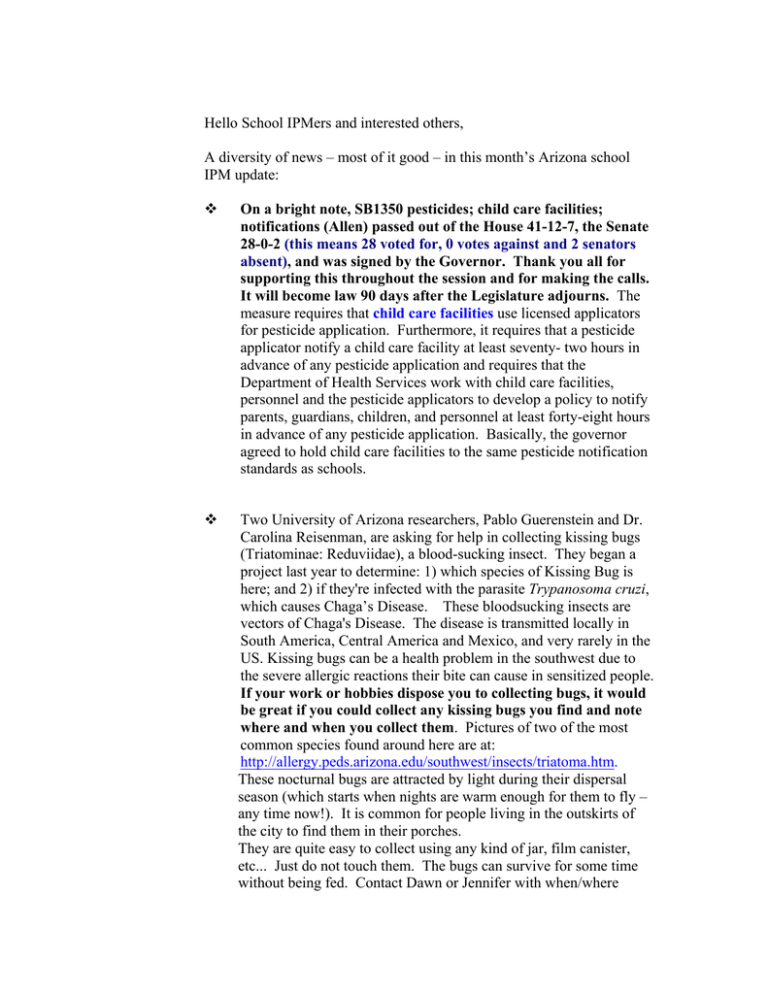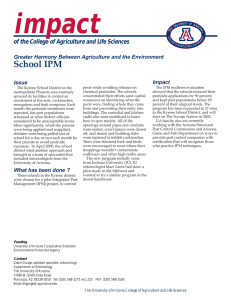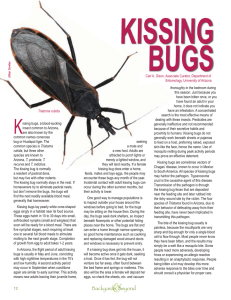Hello School IPMers and interested others,
advertisement

Hello School IPMers and interested others, A diversity of news – most of it good – in this month’s Arizona school IPM update: On a bright note, SB1350 pesticides; child care facilities; notifications (Allen) passed out of the House 41-12-7, the Senate 28-0-2 (this means 28 voted for, 0 votes against and 2 senators absent), and was signed by the Governor. Thank you all for supporting this throughout the session and for making the calls. It will become law 90 days after the Legislature adjourns. The measure requires that child care facilities use licensed applicators for pesticide application. Furthermore, it requires that a pesticide applicator notify a child care facility at least seventy- two hours in advance of any pesticide application and requires that the Department of Health Services work with child care facilities, personnel and the pesticide applicators to develop a policy to notify parents, guardians, children, and personnel at least forty-eight hours in advance of any pesticide application. Basically, the governor agreed to hold child care facilities to the same pesticide notification standards as schools. Two University of Arizona researchers, Pablo Guerenstein and Dr. Carolina Reisenman, are asking for help in collecting kissing bugs (Triatominae: Reduviidae), a blood-sucking insect. They began a project last year to determine: 1) which species of Kissing Bug is here; and 2) if they're infected with the parasite Trypanosoma cruzi, which causes Chaga’s Disease. These bloodsucking insects are vectors of Chaga's Disease. The disease is transmitted locally in South America, Central America and Mexico, and very rarely in the US. Kissing bugs can be a health problem in the southwest due to the severe allergic reactions their bite can cause in sensitized people. If your work or hobbies dispose you to collecting bugs, it would be great if you could collect any kissing bugs you find and note where and when you collect them. Pictures of two of the most common species found around here are at: http://allergy.peds.arizona.edu/southwest/insects/triatoma.htm. These nocturnal bugs are attracted by light during their dispersal season (which starts when nights are warm enough for them to fly – any time now!). It is common for people living in the outskirts of the city to find them in their porches. They are quite easy to collect using any kind of jar, film canister, etc... Just do not touch them. The bugs can survive for some time without being fed. Contact Dawn or Jennifer with when/where collection information and to arrange a “drop”. Thanks for contributing to the research of this public health insect!! **PEST PRESSES are being translated into SPANISH!** So far one issue has been translated, thanks to the efforts of Jaslyn Dobrahner, EPA region 8. All of Arizona’s pest presses (English and Spanish) can be downloaded from the UA Urban Entomology website: http://ag.arizona.edu/urbanipm/schoolipm/newsletters/index.html. It’s MOSQUITO SEASON again. We live in an arid environment where mosquitoes rely on US to breed, and quite suddenly it seems mosquito populations have bloomed! You can prevent West Nile virus and other mosquito-borne diseases by reducing mosquito breeding habitat around your school and home. Two pest presses (2004 and 2005) address mosquito prevention and WNV, both available on the above UA website. Additionally, there are three attached documents here on 1) mosquitoes; 2) insect repellents; 3) a local media article on a recent mosquito virus-related death in Tempe. If you have RSVP’d for the upcoming Arizona Pest Management Summit June 6th and need directions, please e-mail Jennifer Snyder, jsnyder@ag.arizona.edu. This is shaping up to be a wonderfully diverse group of IPM folks, we look forward to seeing you there! If you have any questions, don’t hesitate to contact Dawn or Jennifer… Thanks all! ~Dawn & Jennifer



